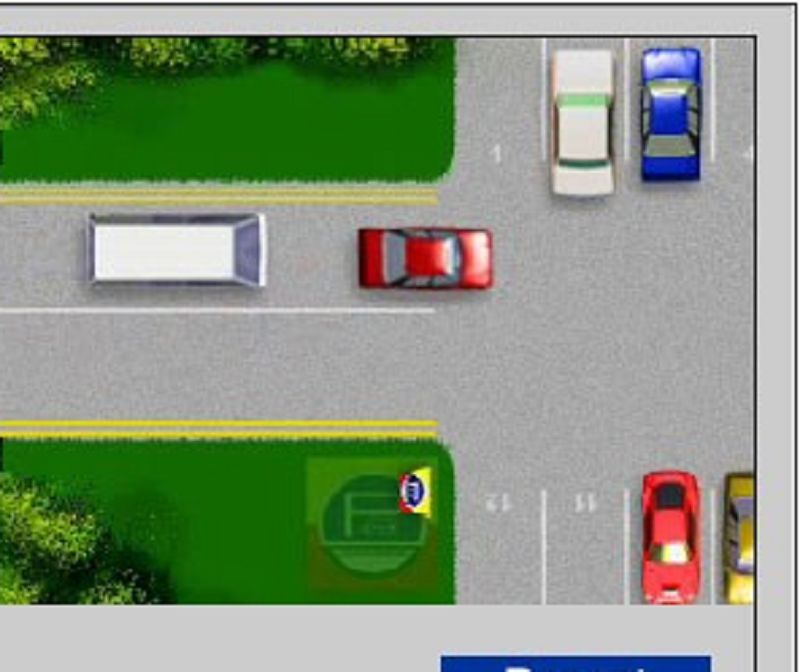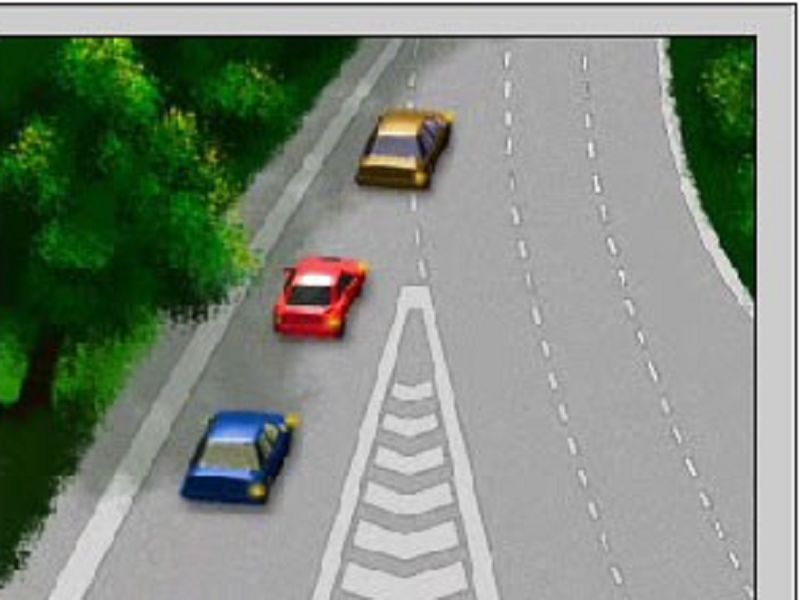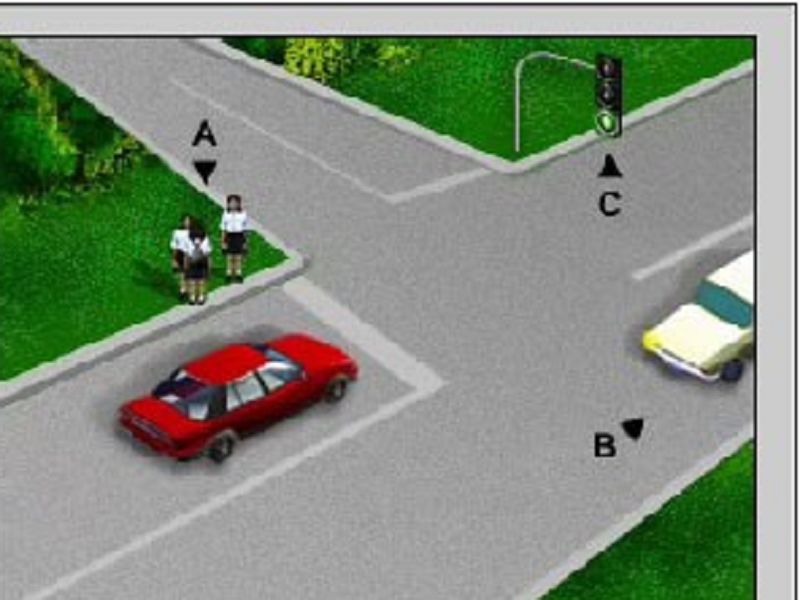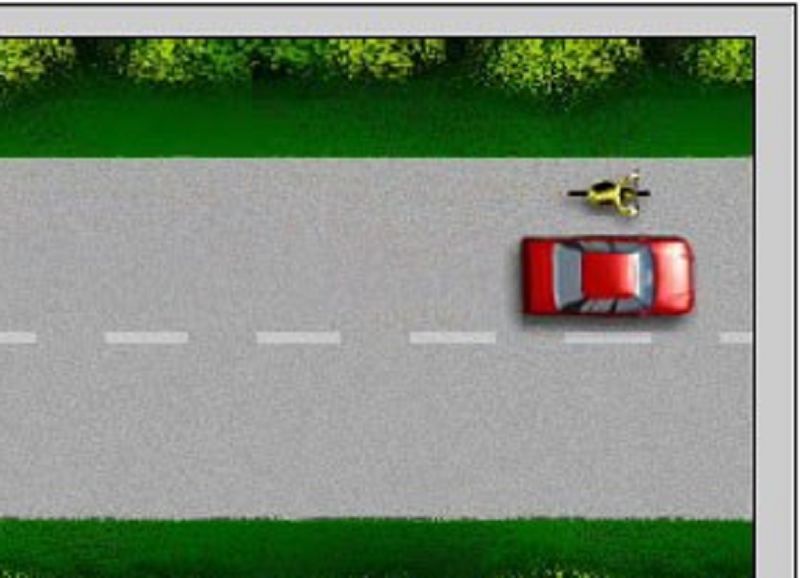Final Theory Prac 1
When driving behind a bus, you should
Keep a longer following distance
Keep a normal following distance
Keep more to the right to have a better view
When you are driving along a main road, you should
Stop at every road junction before proceeding
Accelerate through each junction
Check every side road before you drive past them
You notice a vehicle trying to pull out between a row of stationary vehicles, you should
Drive on regardless of danger ahead
Sound the horn and maintain your speed
Slow down and be prepared to stop
As vehicle speed increases, your field of vision would be
Reduced
Remained the same
Increased
When driving, your arms should be
Straighten
Slightly bent
Bend at 90 degree
Some of the common vehicle defects that can cause accidents are
Faulty seat belts, seats, child restraint and alarm system.
Faulty tyres, brakes, shock absorbers and windscreen wipers.
Dull paint, dented bumpers and old seats.
The handbrakes of a car acts
Only on the rear wheels
Only on the front wheels
On both the front and rear wheels
When passing the stationary bus at the bus-stop, you should
Sound the horn to warn the bus driver of your presence
Speed up to overtake the bus before it moves off
Slow down and ready to stop for pedestrian who may cross the road in front on the bus

Both the van and the car are entering a carpark, the car should not overtake the van
Because of the centre white line
Because of the double yellow line
Because it is not safe to do so
How does alcohol affect you?
It reduces your concentration
It increases your awarness
It improves your co-ordination
The 'Two-second rule' is a sufficient distance between your vehicle and the car in front when road condition is
Wet
Good
Hazy
You will nnot be allowed to apply for a Provisional Driving Licience (PDL) if you have
6 demerit points
9 demerit points
13 demerit points
You will not be allowed to take your driving test if you have
13 demerit points
12 demerit points
24 demerit points
When you hear the siren of an emergency vehicle, you should
Stop immediately when you are in order to make way
Pull over to the left or right side of the road
Sound your horn to warn the front vehicles to speed up.
The safe following distance is
1 car-length for every 5kmh of your speed
1 car-length for every 10kmh of your speed
1 car-length for every 20kmh of your speed
After driving through flood the brakes may malfunction. In order to correct this, you must
Stop the vehicle on a slop to allow water to flow out from the brakes
Pump the brake pedal repeatedly to dry the brakes
Drive at normal speed to spin-dry the brakes
An automatic car has foot pedal/s
One
Two
Three

When entering the expressway, vehicles on the left lane
Should adjust their speed in order to merge in smoothly
Must not slow down or stop
Must stop at the dotted line
The right-most outer lane of the expressway is meant for
Emergency vehicles and overtaking
Vehicles travelling at the maximum speed limit
Slow moving vehicles
Before reaching a junction, you should
Form up into the correct lane which you intend to travel
Sound your horn to caution other road users
Speed up as so not to cause traffic jam
To assist braking when you are travelling downhill, you should use
The front brakes only
Both the front and rear brakes only
Both the front, rear brakes and engine brakes
When the clutch pedal is depressed
Engine-brake will no longer be effective.
Engine-brake will be effective.
Brake linings will be burnt
With gear engaged, engine power is not connected to the wheel when the clutch
Is released
Is applied
It released halfway
You should not depress the clutch when
Stopping
Changing gears
Going round a bend
When you see a bend ahead, you should
Change from 3rd gear to the 4th gear before entering the bend
Depress the clutch as you enter the bend
Change from 4th to 3rd gear before entering the bend
To move off smoothly uphill, you must be good at co-ordinating
The clutch, foot-brake and handbrake
The clutch, accelerator and handbrake
The clutch, foot brake and accelerator
You may overtake another vehicle on the left
If it is a heavy vehicle
If the driver is front signal his intention to turn right
If you are certain that the vehicle would not change direction
While reversing you should
Look at the rear view and side view mirrors
Look through the rear windscreen
Both A and B above
Reversing from a side road into a main road is
Allowed if there is no vehicle around
Not allowed for it is unsafe and could cause road accident
Allowed during the daytime only
Driving with a 'bald' tyre is dangerous because
It skids more easily
There is greater probability of puntures
Both A and B
If the front tyre is punctured,
The car will pull away from the side of the punctured tyre
The car will pull to the side of the punctured tyre.
The car will move from side to side
When negotiating a sharp bend, centrifugal force pushes your vehicle
Inwards
Outwards
Forward
Reaction distance is the distance travelled from the moment, the
Brake is applied to the time the vehicle comes to a stop
Hazard is seen to the time the vehicle comes to a stop
Hazard is seen to the time the brake is applied.
Why is free wheeling wrong?
It will cause the vehicle to skid.
There is no engine braking.
The engine will run faster.
All drivers are required by law to switch on the vehicle's headlights whilst driving between
7.00 pm and 7.00 am
7.15 pm and 7.15 am
7.30 pm and 7.30 am
Switching on the headlights whilst driving in heavy rain during the daytime
Is advisable because you can be readily seen by others
Is not advisable because it will shorten the battery life
Is not advisable because the rain water will reflect the light
As you approach a controlled junction the lights change to green. Elderly people are halfway across, you should
Rev tour engine to make them hurry
Wait because they will take longer to cross
Flash your light to hurry them
When approaching a green traffic light signal at a junction, you must
Speed up to drive through the junction
Slow down and be prepared to stop
Maintain your speed

In this situation, the 'red' car should pay special attention to
The school children
The turning vehicle
the traffic light
When following behind a large vehicle, you should
Move more to the left to have a better view
Leep a longer following distance as you would with other vehicles
Follow at the same distance as you would with other vehicles
The right most outer lane on a three-lane carriageway is for
Emergency vehicles and overtaking only
Vehicles travelling at the maximum speed limit of the road
Vehicles which are capable of travelling at high speed
Generally, overheating of the engine is largely due to
Long distance driving
Poor vehicle maintenance
Lack of petrol
The engine oil level on the dip stick should be
Below the lower marking
Above the upper marking
Between the lower and upper markings
When your vehicle starts to skid while braking, you should
Stop harder on the brake pedal
Release the brakes and apply intermittent braking
Neutralise the gear and apply the front brakes
While driving along an expressway and your handphone (without handsfree kit) rings, you should
Answer the call immediately
Carry on driving and find a safe spot out of the expressway before answering the call
Stop at the road shoulder and answer the call
Is it an offence to drive on the road shoulder of the expressway?
Yes, it is an offence.
It is not an offence.
It is not an offence if the road is congested
When passing a cyclist, what is the minimum side clearance you must ensure between the cyclist and your car?
0.5m
1m
1.5m

When a cyclist in front of you is glancing to the rear, it means that
He might change direction
He is going to stop
He is about to speed up
A turn signal that keeps flashing after a turn is very likely to
Confuse other driver and cause them to turn into your path
Damage the electrical system
Keep other drivers from seeing your brake light
The rear view mirror inside the cabin should be adjusted so that
Only the right hand side of the rear windscreen can be seen in the mirror
Only the left hand side of the rear windscreen can be seen in the mirror
A full view of the rear windscreen can be seen in the mirror
{"name":"Final Theory Prac 1", "url":"https://www.quiz-maker.com/QPREVIEW","txt":"When driving behind a bus, you should, When you are driving along a main road, you should, You notice a vehicle trying to pull out between a row of stationary vehicles, you should","img":"https://www.quiz-maker.com/3012/CDN/90-4423706/ftt-e-p1-q09.jpg?sz=1200-06716000000328408409"}
More Quizzes
W1: Literary Wednesday
1260
Neolitico
10565
Truth Quiz
100
Eaton Iron Throne of ePDU Quiz
1780
External Anatomy of the Spinal Cord: Test Your Knowledge
201081775
Challenge Yourself With Our Current Events Trivia!
201034220
Ultimate State Capitals Northeast
201052219
Discover Your Inner Villainous Show Character - Free
201031678
Find Your Ideal Snapchat BFF - Friends Snapchat
201028300
College Logo Challenge: Can You Score 100%?
201081775
Tax in Action - VITA
15832891
Test Your Skills: One Step Equations with Integers
201031678